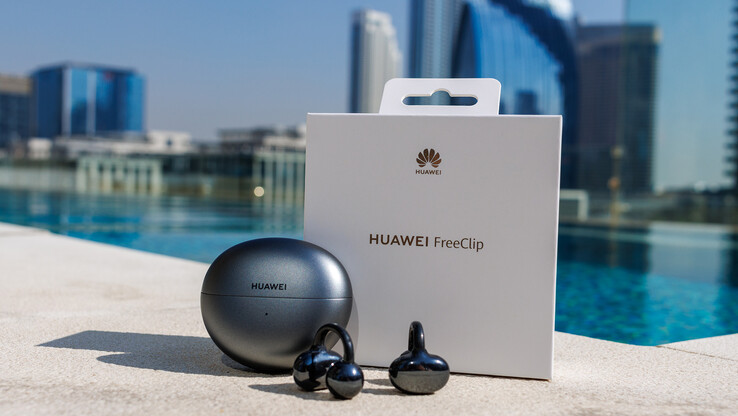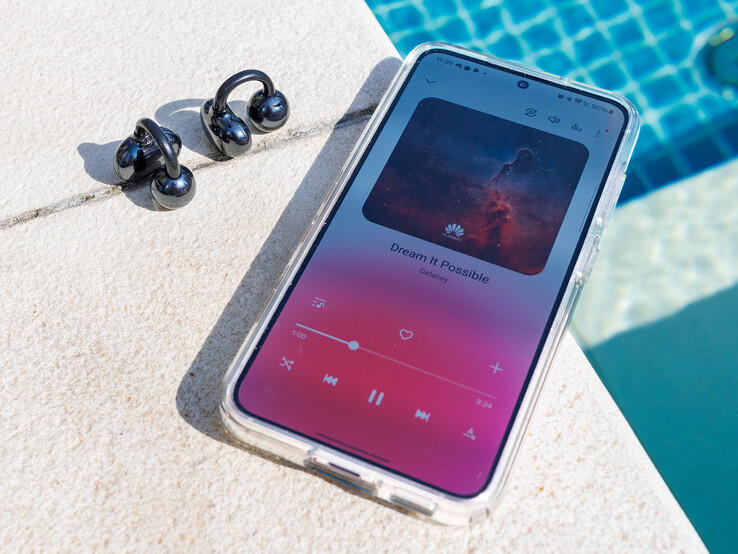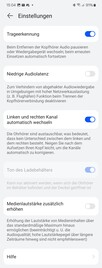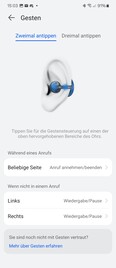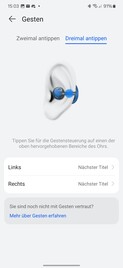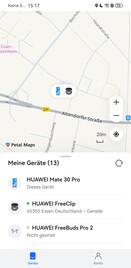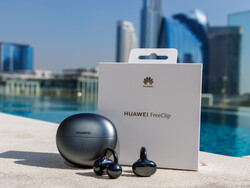Huawei FreeClip review - Open-ear headphones with an innovative design
The Huawei FreeClip takes a different approach to the company's previous headphones. Unlike the FreeBuds 5, which rely on an in-ear design with an open-fit, the FreeClip do not fit between the tragus and antitragus and are not inserted into the ear canal, as is the case with the FreeBuds Pro 3. Instead, the so-called C-bridge, an innovative ear hook, is used to clamp the headphones to the ear.
In particular, Huawei wants to attack a market niche that is currently only occupied by the Shokz OpenFit which rely on a classic ear hook. We will find out whether this works in the test.
Specifications
| Wearing style | Open-Ear |
| Connectivity | Bluetooth 5.3 |
| Range | 10 m |
| Speaker | 10.8 mm dual magnet driver, 20 - 20000 Hz |
| Audio codecs | SBC, AAC, L2HC, LC3 |
| Battery capacity | 55 mAh (earphones), 510 mAh (charging case) |
| Charging port | USB-C |
| wireless charging | Yes |
| Weight | 5.6 g (earphones), 44.5 g (charging case) |
| Firmware version | HarmonyOS 4.0.0.112 |
| Scope of delivery | Headphones, charging case, USB-C cable, documentation |
| Price (RRP) | 199 Euro |
Case and ergonomics - FreeClip with IP54 certification
The Huawei FreeClip is available in the colors purple and black. The purple version actually has more of a pearly, shimmering surface with a purple accent, while the black version is more of a silvery anthracite. Thanks to the matt surfaces, they are definitely resistant to dirt.
The workmanship is convincing in the test, and the C-bridge also appears very solid and yet flexible. Although it is encased in a rubber-like plastic, underneath is a nickel-titanium alloy, which is not only very flexible but also always returns the two elements to the same distance. As a result, this remains at what Huawei describes as an optimum hearing comfort curvature of 11.4 degrees. The clamping force is said to be 0.15 newtons.
It all sounds very technical, but works very reliably in everyday use. The C-bridge connects the two other elements: the comfort bean and the acoustic ball. The latter houses a microphone, the VPU bone sensor (VPU: Voice Pick Up), and the speaker, while the bean, which is worn behind the ear, contains the battery and a wind-protected microphone. In the test, the C-bridge can also be bent backward by 270 degrees without any problems; when it is then released, it snaps back into its original position. If you try this out, you should watch your fingers.
There is no need to get used to putting on the Huawei FreeClip, the earphones slide naturally onto the ear and stay securely in place even during sporty movements. When wearing them, you quickly forget that the FreeClip are there, and there is no feeling of pressure even after wearing them for several hours.
The Huawei FreeClip are IP54-certified and therefore protected against the ingress of harmful amounts of dust and splash water.
Features and operation - Dual Bluetooth and modern audio codecs
The setup of the Huawei FreeClip is identical to that of other headphones from the manufacturer such as the FreeBuds Pro 3. If you have a Huawei smartphone with at least EMUI 10 or HarmonyOS 2, a connection to the headphones is suggested as soon as the charging case is opened for the first time. However, Google's Fast Pair is not supported, whereas Microsoft's Swift Pair is. Alternatively, a classic manual pairing can be performed. The Huawei headphones are capable of dual connectivity and can be paired with two devices at the same time; the pairing list can manage up to eight devices.
The AI Life app is required to use the FreeClip with all its benefits. Apple Users can find this in the App Store; it is usually pre-installed on Huawei smartphones or can be downloaded from the AppGallery. Only Google users have to take a slightly more complicated route by downloading the app via the QR code on the packaging or directly from the Huawei website.
Not only can firmware updates be installed in the app, but equalizers can also be set, wearer detection can be switched on or off, and touch operation can be adapted to individual requirements. In this respect, there are also a few special features of the FreeClip, as they have touch-sensitive surfaces on the bean, the bridge, and the ball, which react to double or triple taps. In addition, there is no left or right earbud, they can be used either way and the integrated sensors recognize which side they are on. We are already familiar with these functions from the Watch Buds and also works very reliably with the FreeClip. The earbuds can also be used individually so that nothing stands in the way of monaural use.
If you use a Huawei smartphone or tablet, you can also adjust the sound quality in the app. The search function then not only includes acoustic location via played sounds but the last location of the headphones can also be displayed on a map. However, Huawei does not offer UWB support.
The audio codec features go beyond SBC and AAC. Huawei products can use the high-resolution L2HC codec. At Android 14 on the Pixel 8, we were also offered Spatial Audio. LC3 is also nominally supported, but we were only able to establish an AAC connection on the Pixel. It is not yet entirely clear whether this is reserved exclusively for Windows or will be added via an update. We are still waiting for an answer from Huawei in this regard. As soon as we have this, we will update the article accordingly.
Sound - Powerful sound and lots of AI
The Huawei FreeClip uses the same drivers as the FreeBuds 5 and the chipset from the Eyewear II, but they achieve a much better sound, which has more to offer, especially in the mid and lower frequency ranges, and therefore sounds fuller and more immersive in the ear. This is also pretty close to the Shokz OpenFit but these have a more powerful bass and therefore more depth. Nevertheless, Huawei also achieves really good multimedia sound considering the size. By inverting the sound waves, the sound is not only emitted directly into the ear but also hardly anything penetrates the environment.
Functions such as HearThrough or ANC are not on board. However, this is not surprising, as the former is superfluous due to the open-wearing style, as the surroundings remain fully audible at all times. The lack of ANC can also be explained by the design, but it is still an important feature when traveling.
Unfortunately, we cannot confirm the "crystal-clear calls" promised by Huawei. In fact, the call partners are very easy to understand, but the FreeClip user is a little scratchy to noisy. We would have expected this to be clearer. The positive surprise, however, is that this quality is very consistent, and even loud background noise is very reliably eliminated by the AI. Even in windy conditions, the FreeClip user's voice remains easy to understand.
| Loudspeakers | |
| THD | |
| Samsung Galaxy Buds2 Pro (RMS: -3.0 dBFS) | |
| Huawei FreeClip (RMS: -1.1 dBFS) | |
| Shokz OpenFit (RMS: -1.5 dBFS) | |
| THD+N | |
| Samsung Galaxy Buds2 Pro (RMS: -3.0 dBFS) | |
| Huawei FreeClip (RMS: -1.1 dBFS) | |
| Shokz OpenFit (RMS: -1.5 dBFS) | |
* ... smaller is better
THD (Total Harmonic Distortion): Harmonic distortion quantifies the distortion caused by non-linear components (harmonic content) in relation to the original signal. THD specifically refers to the fundamental component. It's important to note that while the term "distortion factor" is often used interchangeably, it actually refers to the overall signal, not just the fundamental component.
THD+N (Total Harmonic Distortion + Noise): This value is comparable to THD, but in addition to measuring the interference power of harmonics, it also takes into account the impact of noise as an effective value. For the measurement, a low harmonic sinusoidal signal (typically at 1 kHz and > 0 dB) is played back through the headphones under test. This signal is then recorded by a linear measuring microphone (placed at a measuring distance of approximately 0.40 inches) in an artificial head.
Both THD and THD+N values are expressed as percentages. The lower the value, the higher the fidelity of the signal.
Huawei FreeClip audio analysis
(+) | speakers can play relatively loud (89.2 dB)
Bass 100 - 315 Hz
(+) | good bass - only 1.8% away from median
(+) | bass is linear (2.9% delta to prev. frequency)
Mids 400 - 2000 Hz
(+) | balanced mids - only 2% away from median
(+) | mids are linear (1.8% delta to prev. frequency)
Highs 2 - 16 kHz
(±) | higher highs - on average 10% higher than median
(±) | linearity of highs is average (7.9% delta to prev. frequency)
Overall 100 - 16.000 Hz
(+) | overall sound is linear (9.3% difference to median)
Compared to same class
» 3% of all tested devices in this class were better, 1% similar, 96% worse
» The best had a delta of 4%, average was 24%, worst was 134%
Compared to all devices tested
» 3% of all tested devices were better, 1% similar, 96% worse
» The best had a delta of 4%, average was 24%, worst was 134%
Shokz OpenFit audio analysis
(+) | speakers can play relatively loud (90.8 dB)
Bass 100 - 315 Hz
(+) | good bass - only 4.8% away from median
(+) | bass is linear (2.9% delta to prev. frequency)
Mids 400 - 2000 Hz
(+) | balanced mids - only 1.7% away from median
(+) | mids are linear (1.6% delta to prev. frequency)
Highs 2 - 16 kHz
(±) | higher highs - on average 6.5% higher than median
(+) | highs are linear (6.7% delta to prev. frequency)
Overall 100 - 16.000 Hz
(+) | overall sound is linear (9.6% difference to median)
Compared to same class
» 4% of all tested devices in this class were better, 1% similar, 96% worse
» The best had a delta of 4%, average was 24%, worst was 134%
Compared to all devices tested
» 4% of all tested devices were better, 1% similar, 96% worse
» The best had a delta of 4%, average was 24%, worst was 134%
Battery life - FreeClip lasts over 9 hours
The batteries in the earphones of the Huawei FreeClip each have a capacity of 55 mAh and showed a very high endurance of almost nine and a half hours in our runtime test with an adjusted volume of 65 dB(A), which even exceeds Huawei's specification (eight hours).
Ten minutes of charging should be enough for up to three hours of playtime. The charging case can be charged via the integrated USB-C port or wirelessly (Qi).
| Battery Runtime - Spotify loop at 65dB/A (incl ANC) | |
| Huawei FreeClip | |
| Samsung Galaxy Buds2 Pro | |
| Shokz OpenFit | |
Verdict - Huawei FreeClip are more than just a pretty accessory
The Huawei FreeClip are packed with modern technology and look really stylish. Thanks to the design with the C-bridge developed by Huawei, even spectacle wearers can use the headphones despite the small earpiece. The FreeClip deliver an appealing sound, high wearing comfort, and impress with their long battery life.
The Huawei FreeClip combine a unique design with appealing sound characteristics.
So far, the call quality has been less convincing. Although our call partners are easy to understand, the FreeClip user's voice is not as clear as advertised. Hopefully, Huawei can improve this with an update. The headphones are otherwise predestined for telephony thanks to dual Bluetooth and their good ambient noise suppression. However, the lack of ANC does not make them ideal companions on train or plane journeys.
If sound output, battery life, and the form factor are important to you, you can purchase the Huawei FreeClip without hesitation. Those who prefer a functional design with a more powerful sound should consider the Shokz OpenFit. If the earphones can also be placed in the ear canal and ANC is a must, the Jabra Elite 10 are a strong alternative.
Price and availability
The FreeClip is initially only available directly from Huawei.
Anyone who orders by 31.01.2024 will receive a Huawei Band 8 free of charge.
Transparency
The selection of devices to be reviewed is made by our editorial team. The test sample was given to the author by the manufacturer free of charge for the purposes of review. There was no third-party influence on this review, nor did the manufacturer receive a copy of this review before publication. There was no obligation to publish this review. As an independent media company, Notebookcheck is not subjected to the authority of manufacturers, retailers or publishers.
This is how Notebookcheck is testing
Every year, Notebookcheck independently reviews hundreds of laptops and smartphones using standardized procedures to ensure that all results are comparable. We have continuously developed our test methods for around 20 years and set industry standards in the process. In our test labs, high-quality measuring equipment is utilized by experienced technicians and editors. These tests involve a multi-stage validation process. Our complex rating system is based on hundreds of well-founded measurements and benchmarks, which maintains objectivity. Further information on our test methods can be found here.




